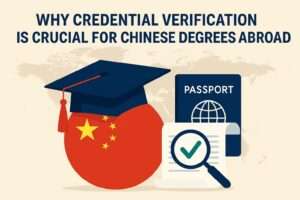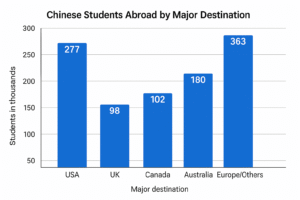
China is home to one of the world’s largest higher‑education systems. More than 50 million students are enrolled in universities across the country, and there are well over 2,800 recognised institutions. As the Chinese economy has grown and household incomes have increased, outbound study has exploded. UNESCO figures show that over 1 million Chinese students were studying for a degree abroad in 2023, making China the world’s largest source of international students. In the United States alone, there were approximately 277,000 Chinese students in the 2023/24 academic year, and Canada hosted more than 102,000 Chinese students in 2023. The UK remains a popular destination, with approximately 98,400 new Chinese students entering UK universities in the 2023/24 academic year.
Behind these statistics are real people who must prove that their Chinese qualifications are authentic. Many universities, employers, and immigration authorities will not process applications without official verification. Fraudulent credentials and misrepresentation have become a growing problem in the international education market, prompting tighter checks. This guide explains why verifying Chinese degrees is essential and outlines the steps involved in obtaining an evaluation for study or work abroad.
Understanding China’s Dual‑Credential System
China issues two key documents upon completion of higher education:
- Graduation Certificate (毕业证书) – confirms that a student has completed the required coursework of a program. Students may graduate without receiving a degree if they do not meet the academic requirements for a thesis or research of high quality.
- Degree Certificate (学位证书) – awarded to students who have met the requirements for a bachelor’s, master’s, or doctoral degree, including successful defence of a thesis or dissertation.
Both documents are essential for a complete academic record. It is possible to hold a graduation certificate without a degree certificate, and vice versa. Employers and admissions offices overseas often require verification of both certificates and a course‑by‑course transcript. China’s Ministry of Education has designated the Center for Student Services and Development (CSSD) to manage all verification through the China Higher Education Student Information and Career Center (CHSI). In August 202,2, the Ministry consolidated degree verification under CSSD, making CHSI the sole official portal for verifying both graduation and degree certificates. This centralised system reduces the risk of fraud and provides a single “source of truth” for Chinese qualifications.
Why Verification Matters
Admissions and Academic Planning
Foreign universities use credential evaluations to understand how Chinese qualifications compare to their own academic standards. A verified report confirms the level of your degree, the field of study, and the credits you earned. Without this, admissions officers cannot determine whether you meet entry requirements, particularly for graduate programmes. Verification is especially important for professional degrees such as MBAs, engineering, or medicine, which have strict prerequisites.
Employment and Professional Licensing
Employers need assurance that a candidate’s education meets local standards. Verified credentials help employers decide whether to offer internships or full‑time positions, and professional licensing boards often require evidence that a degree is genuine. For example, Chinese MBAs must be verified to show that they meet the minimum number of credit hours and that the awarding institution is recognised.
Immigration and Visa Applications
Immigration authorities often request credential evaluations to prove that a degree is real and equivalent to a local qualification. A verified Chinese degree can speed up visa processing and reduce the risk of rejection. As China is the largest sender of international students, some countries have tightened visa checks. Having your documents authenticated demonstrates compliance and eases concerns about fraud.
Preventing Fraud
The global education market has witnessed an increase in counterfeit degrees and falsified transcripts. Verification through CHSI ensures that your documents are authentic and discourages fraudulent activity. Employers and institutions rely on the official CHSI report rather than photocopies or unverified translations. Submitting unverified documents can lead to delays or rejections and may damage your credibility.
Step‑by‑Step Guide to Verifying Your Chinese Credentials
Verifying your Chinese degree involves several distinct stages. The process can take several weeks, so it’s best to start early to meet application deadlines.
- Confirm Institutional Recognition. Before beginning the verification process, ensure that your university is authorised by China’s Ministry of Education. China has more than 2 800 recognised higher‑education institutions. Degrees from unrecognised institutions or unregistered joint programmes may not be accepted abroad.
- Gather Original Documents. Collect your graduation certificate, degree certificate and transcript. If your degree was issued before 2008 or by a military institution, you may need to use specific verification channels. Keep your passport (or Chinese ID) and consider preparing notarised English translations if the documents are in Chinese. Certified translations may be required later for legalisation.
- Create a CHSI Account and Verify Your Identity. Go to the CHSI website (https://www.chsi.com.cn) and register. You’ll need to provide personal information (name, ID or passport number, contact details) and complete an identity verification step. Identity verification may involve scanning your Chinese ID through the CHSI app or submitting documents for manual review.
- Bind Your Academic Credentials. After your account is verified, link (or “bind”) your graduation and degree certificates to your profile by entering the certificate numbers. The CHSI system cross‑checks the numbers against the national database. Credentials issued after 2001 are typically verified instantly; older credentials may require manual confirmation.
- Request the Correct Verification Report. CHSI offers several types of reports, so choose the one required by the receiving institution:
- Online Verification Report of Higher Education Qualification Certificate (学历证书电子注册备案表): proves you completed a programme and is often required for employment or further study in China.
- Online Verification Report of Higher Education Degree Certificate (学位在线验证报告): confirms the award of a bachelor’s, master’s or doctoral degree and is essential for international university admissions and professional licensing.
- Verification Report of Academic Transcript (大学成绩验证报告): provides course‑by‑course grades. Most foreign universities require this report.
- Verification Report of College Admission Examination Scores (高考成绩验证报告): verifies Gaokao scores and may be required for undergraduate admissions.
- Set Validity and Pay. You can set how long the report remains accessible (usually up to 180 days). Pay the required fee online. CHSI will generate a bilingual PDF report with a unique report number and QR code for authentication.
- Obtain Certified Translations. If your target institution requires documentation in a language other than English, have your certificates and reports translated by a qualified translator. Certified translations must include the translator’s statement of accuracy and may need notarisation. Some countries require an apostille or consular legalisation after translation to make the document legally valid.
- Submit to Evaluation Agencies. Once you have the CHSI verification report and translations, submit them to a credential evaluation agency (such as ACEI Global, IERF, or ECE). Many agencies also require sealed transcripts sent directly from your university, so contact your institution’s registrar’s office. Processing times vary. For example, WES typically completes evaluations within approximately seven business days after receiving all materials; however, secondary verification can extend the timeline. Keep track of your application status through the evaluation agency’s portal.
- Follow Up and Use Your Evaluation. When your evaluation is complete, you’ll receive a report indicating the equivalency of your Chinese degree. Use this report when applying for university admission, professional licensing, or employment. Keep copies for future immigration applications or credential reviews.
Common Challenges and How to Avoid Them
Unrecognised Institutions. Verify your institution’s status on the Chinese Ministry of Education’s list of authorised universities. Degrees from unapproved institutions or programmes may not be accepted.
Incomplete Documentation. Missing documents or discrepancies in names and dates can cause delays. Ensure that your personal details match exactly across all documents, translations, and applications.
Translation Errors. Only certified translations are accepted. Word‑for‑word accuracy is crucial; summarised translations will be rejected.
Not Verifying Both Certificates. Please note that you will need both the graduation certificate and the degree certificate. Submitting only one may result in a partial evaluation or rejection.
Timing and Costs. Begin the process at least 2–3 months before your application deadline. Fees include CHSI report charges, translation costs, notarisation, legalisation, and evaluation agency fees. Budget accordingly.
Understanding Equivalency. Chinese junior college diplomas are generally considered equivalent to an Associate Degree in the United States, while four‑year bachelor’s degrees equate to U.S. bachelor’s degrees. Knowing these equivalences helps set realistic expectations.
Visualising the Chinese Student Footprint Abroad
The chart below illustrates the approximate distribution of Chinese students across major study destinations in 2023/24. The numbers are rounded estimates based on recent data, highlighting the scale of outbound mobility and underscoring the importance of credential verification.

Tips for Chinese Students Seeking an MBA Abroad
- Check Program Recognition. Many Chinese MBA programmes are offered by universities that may not have international accreditation. Verify that China’s Ministry of Education recognises your MBA and that it satisfies admission criteria for foreign universities (e.g., minimum credit hours, accreditation through AACSB or EQUIS).
- Prepare Transcripts Early. MBA admissions committees often require detailed transcripts that show coursework in management, finance, and quantitative subjects. Request CHSI verification reports for both your degree and your transcript.
- Understand Work Experience Requirements. Western MBA programmes typically expect several years of professional experience. Prepare a résumé and secure reference letters to complement your academic credentials.
- Plan for English Proficiency Tests. TOEFL or IELTS scores are usually required. Schedule these examinations early so that scores are available when submitting your credential evaluation.
- Keep a Financial Cushion. MBA programmes can be expensive; consider applying for scholarships, seeking employer sponsorship, or saving for the costs. Budget for verification and translation costs as part of your application expenses.
Best Practices for a Smooth Credential Evaluation
- Start Early. Begin the verification process at least six months before your target application deadlines to allow time for translations, notarisation, and evaluation processing.
- Use Official Channels. Only order reports from CHSI (CSSD). Avoid third‑party “agents” who promise expedited verification, as they may not be authorised and could risk your data.
- Choose the Right Evaluation Service. Select an evaluation agency recognised by universities and professional boards in your destination country. ACEI Global operating under AICE standards is widely accepted.
- Maintain Consistency. Ensure your name appears exactly as it does on your passport in all documents and translations. If you’ve changed your name, provide supporting documentation.
- Keep Copies. Retain digital and hard copies of your certificates, transcripts, translation and verification reports. You may need them for future applications, visas or credential reviews.
Conclusion
Verifying your Chinese degree is not merely a bureaucratic requirement; it is a critical step to ensure your hard‑earned credentials are recognised and valued abroad. With over a million Chinese students studying in foreign universities and more than 100 000 Chinese graduates seeking opportunities in Canada, the demand for reliable verification has never been greater. A CHSI verification report provides an authoritative record of your academic achievements, and a professional credential evaluation translates your qualifications into terms understood by admissions officers, employers, and licensing boards around the world.
ACEI Global has decades of experience evaluating Chinese qualifications. Our experts understand the intricacies of China’s dual‑credential system, the requirements of CHSI, and the expectations of universities and professional bodies worldwide. By choosing ACEI Global, you ensure that your Chinese degree is presented accurately and fairly, maximising your chances of admission, licensure, and employment.
Ready to take the next step? Contact ACEI Global today to begin your credential evaluation. Let us help you unlock global opportunities with confidence and clarity.



